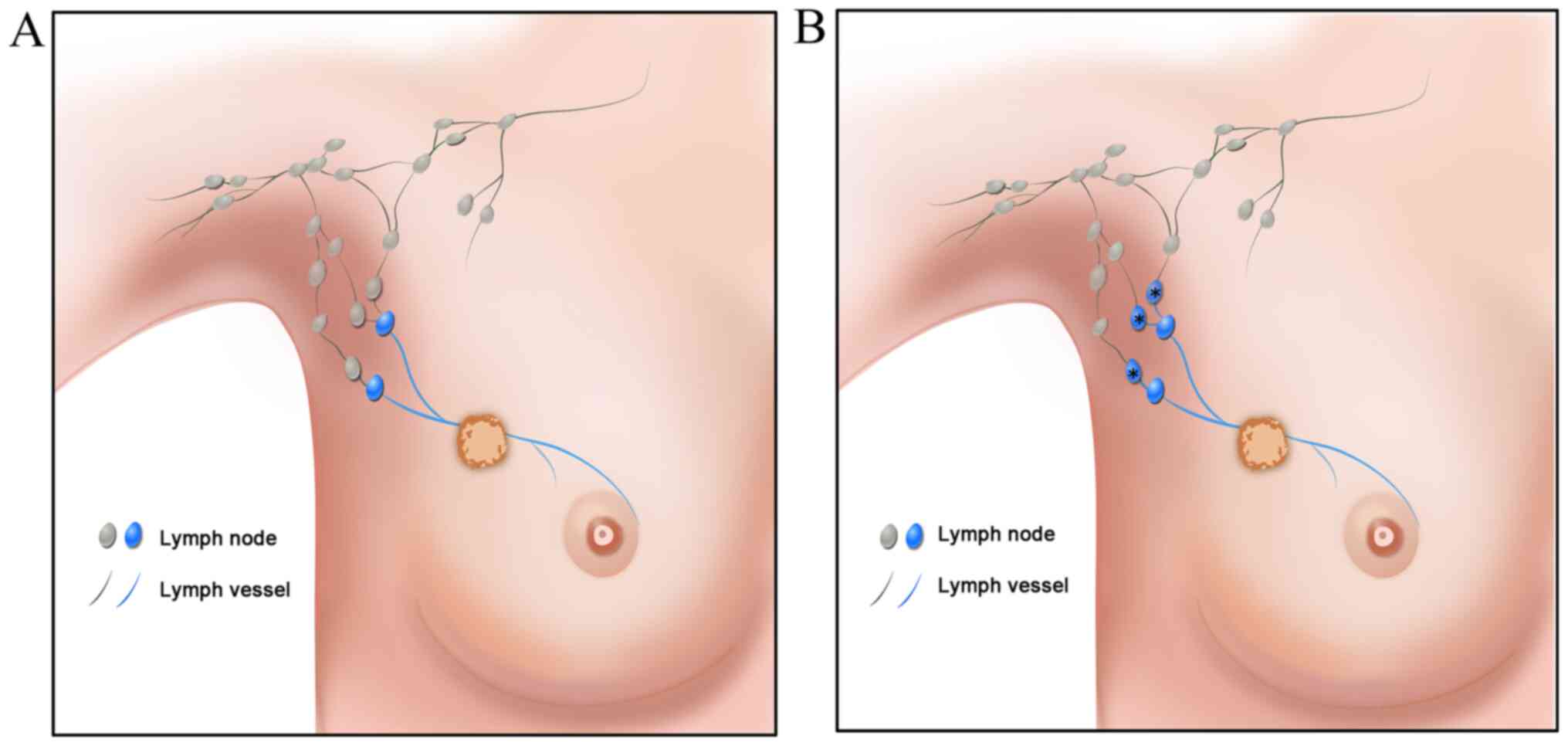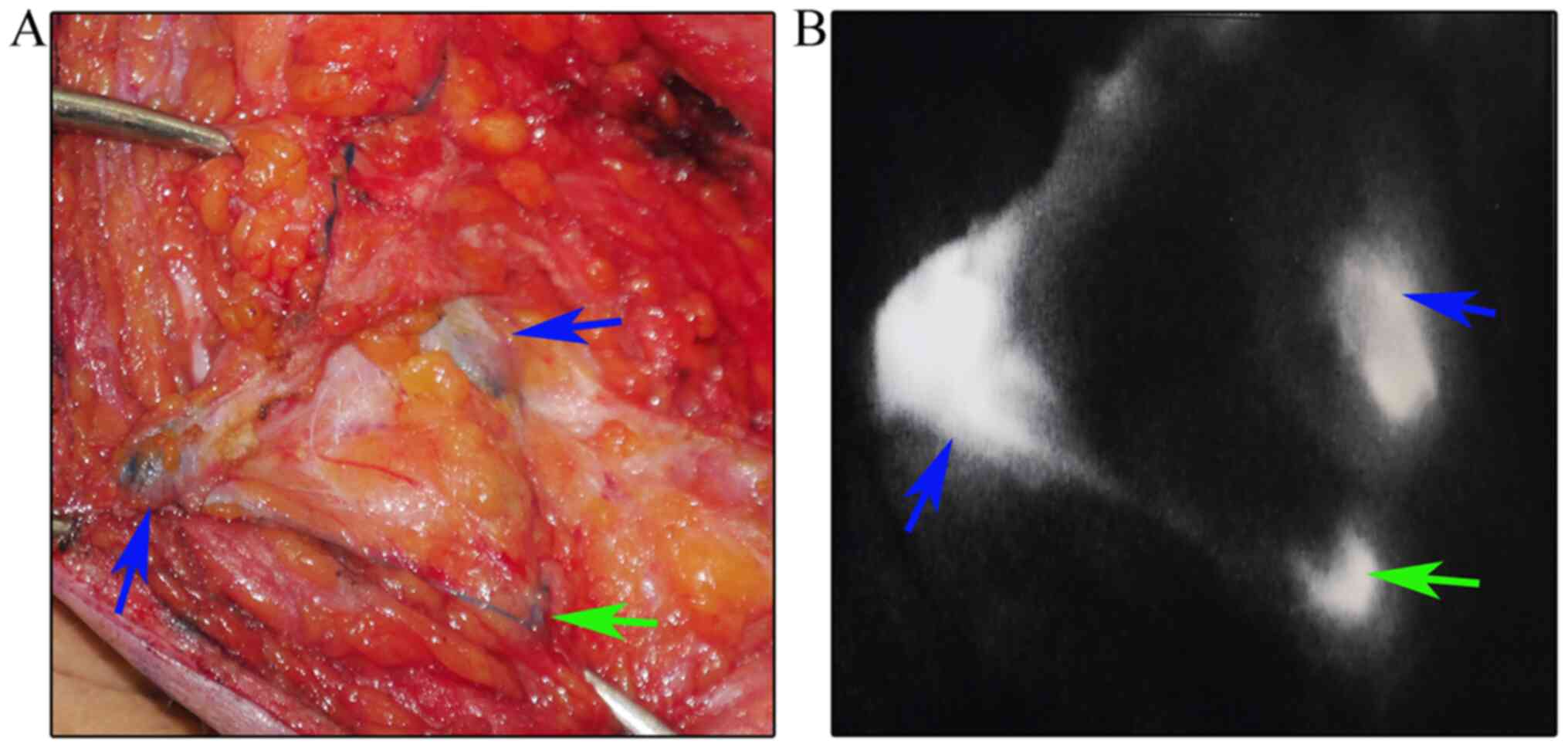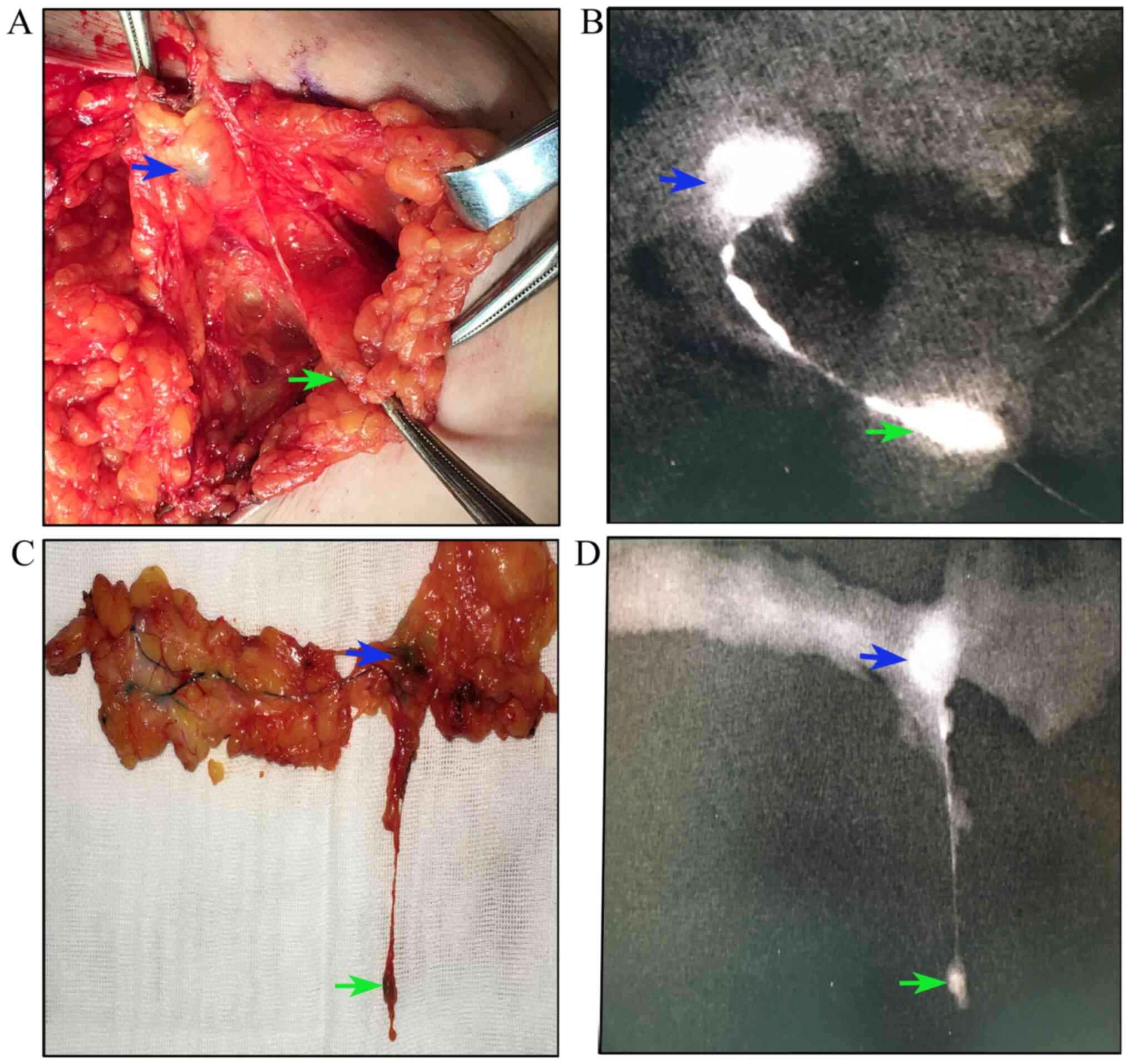|
1
|
Manca G, Tardelli E, Rubello D, Gennaro M,
Marzola MC, Cook GJ and Volterrani D: Sentinel lymph node biopsy in
breast cancer: A technical and clinical appraisal. Nucl Med Commun.
37:570–576. 2016. View Article : Google Scholar : PubMed/NCBI
|
|
2
|
Lyman GH, Temin S, Edge SB, Newman LA,
Turner RR, Weaver DL, Benson AB III, Bosserman LD, Burstein HJ,
Cody H III, et al: Sentinel lymph node biopsy for patients with
early-stage breast cancer: American society of clinical oncology
clinical practice guideline update. J Clin Oncol. 32:1365–1383.
2014. View Article : Google Scholar : PubMed/NCBI
|
|
3
|
Vuthaluru S and Srivastava A: Axillary vs.
sentinel lymph node dissection for invasive breast cancer. JAMA.
305:22902011. View Article : Google Scholar : PubMed/NCBI
|
|
4
|
Lyman GH, Somerfield MR, Bosserman LD,
Perkins CL, Weaver DL and Giuliano AE: Sentinel lymph node biopsy
for patients with early-stage breast cancer: American society of
clinical oncology clinical practice guideline update. J Clin Oncol.
35:561–564. 2017. View Article : Google Scholar : PubMed/NCBI
|
|
5
|
Yi M, Meric-Bernstam F, Ross MI, Akins JS,
Hwang RF, Lucci A, Kuerer HM, Babiera GV, Gilcrease MZ and Hunt KK:
How many sentinel lymph nodes are enough during sentinel lymph node
dissection for breast cancer? Cancer. 113:30–37. 2008. View Article : Google Scholar : PubMed/NCBI
|
|
6
|
Kim MK, Park HS, Kim JY, Kim S, Nam S,
Park S and Kim SI: The clinical implication of the number of lymph
nodes harvested during sentinel lymph node biopsy and its effects
on survival outcome in patients with node-negative breast cancer.
Am J Surg. 214:726–732. 2017. View Article : Google Scholar : PubMed/NCBI
|
|
7
|
Boughey JC, Ballman KV, Hunt KK, McCall
LM, Mittendorf EA, Ahrendt GM, Wilke LG and Le-Petross HT: Axillary
ultrasound after neoadjuvant chemotherapy and its impact on
sentinel lymph node surgery: Results from the American college of
surgeons oncology group Z1071 trial (alliance). J Clin Oncol.
33:3386–3393. 2015. View Article : Google Scholar : PubMed/NCBI
|
|
8
|
Boileau JF, Poirier B, Basik M, Holloway
CMB, Gaboury L, Sideris L, Meterissian S, Arnaout A, Brackstone M,
McCready DR, et al: Sentinel node biopsy after neoadjuvant
chemotherapy in biopsy-proven node-positive breast cancer: The SN
FNAC study. J Clin Oncol. 33:258–264. 2015. View Article : Google Scholar : PubMed/NCBI
|
|
9
|
Zakaria S, Degnim AC, Kleer CG, Diehl KA,
Cimmino VM, Chang AE, Newman LA and Sabel MS: Sentinel lymph node
biopsy for breast cancer: How many nodes are enough? J Surg Oncol.
96:554–559. 2007. View Article : Google Scholar : PubMed/NCBI
|
|
10
|
Liedtke C, Jackisch C, Thill M, Thomssen
C, Müller V and Janni W; AGO Breast Committee, : AGO
recommendations for the diagnosis and treatment of patients with
early breast cancer: Update 2018. Breast Care (Basel). 13:196–208.
2018. View Article : Google Scholar : PubMed/NCBI
|
|
11
|
Sugie T, Kinoshita T, Masuda N, Sawada T,
Yamauchi A, Kuroi K, Taguchi T, Bando H, Yamashiro H, Lee T, et al:
Evaluation of the clinical utility of the ICG fluorescence method
compared with the radioisotope method for sentinel lymph node
biopsy in breast cancer. Ann Surg Oncol. 23:44–50. 2016. View Article : Google Scholar : PubMed/NCBI
|
|
12
|
Inoue T, Nishi T, Nakano Y, Nishimae A,
Sawai Y, Yamasaki M and Inaji H: Axillary lymph node recurrence
after sentinel lymph node biopsy performed using a combination of
indocyanine green fluorescence and the blue dye method in early
breast cancer. Breast Cancer. 23:295–300. 2016. View Article : Google Scholar : PubMed/NCBI
|
|
13
|
Lorek A, Boratyn-Nowicka A and
Szlachta-Światkowska E: Sentinel lymph node (sln) in breast cancer.
Review of current identification methods. Wiad Lek. 70:85–91.
2017.PubMed/NCBI
|
|
14
|
Percy DB, Pao JS, McKevitt E, Dingee C,
Kuusk U and Warburton R: Number of nodes in sentinel lymph node
biopsy for breast cancer: Are surgeons still biased? J Surg Oncol.
117:1487–1492. 2018. View Article : Google Scholar : PubMed/NCBI
|
|
15
|
Shen S, Xu Q, Zhou Y, Mao F, Guan J and
Sun Q: Comparison of sentinel lymph node biopsy guided by blue dye
with or without indocyanine green in early breast cancer. J Surg
Oncol. 117:1841–1847. 2018. View Article : Google Scholar : PubMed/NCBI
|
|
16
|
Tong M, Guo W and Gao W: Use of
fluorescence imaging in combination with patent blue dye versus
patent blue dye alone in sentinel lymph node biopsy in breast
cancer. J Breast Cancer. 17:250–255. 2014. View Article : Google Scholar : PubMed/NCBI
|
|
17
|
Hirano A, Kamimura M, Ogura K, Kim N,
Hattori A, Setoguchi Y, Okubo F, Inoue H, Miyamoto R, Kinoshita J,
et al: A comparison of indocyanine green fluorescence imaging plus
blue dye and blue dye alone for sentinel node navigation surgery in
breast cancer patients. Ann Surg Oncol. 19:4112–4116. 2012.
View Article : Google Scholar : PubMed/NCBI
|
|
18
|
Papadia A, Gasparri ML, Buda A and Mueller
MD: Sentinel lymph node mapping in endometrial cancer: Comparison
of fluorescence dye with traditional radiocolloid and blue. J
Cancer Res Clin Oncol. 143:2039–2048. 2017. View Article : Google Scholar : PubMed/NCBI
|
|
19
|
Pitsinis V, Provenzano E, Kaklamanis L,
Wishart GC and Benson JR: Indocyanine green fluorescence mapping
for sentinel lymph node biopsy in early breast cancer. Surg Oncol.
24:375–379. 2015. View Article : Google Scholar : PubMed/NCBI
|
|
20
|
van der Vorst JR, Schaafsma BE, Verbeek
FP, Hutteman M, Mieog JSD, Lowik CWG, Liefers GJ, Frangioni JV, van
de Velde CJH and Vahrmeijer AL: Randomized comparison of
near-infrared fluorescence imaging using indocyanine green and
99(m) technetium with or without patent blue for the sentinel lymph
node procedure in breast cancer patients. Ann Surg Oncol.
19:4104–4111. 2012. View Article : Google Scholar : PubMed/NCBI
|
|
21
|
Hirche C, Murawa D, Mohr Z, Kneif S and
Hunerbein M: ICG fluorescence-guided sentinel node biopsy for
axillary nodal staging in breast cancer. Breast Cancer Res Treat.
121:373–378. 2010. View Article : Google Scholar : PubMed/NCBI
|
|
22
|
Toh U, Iwakuma N, Mishima M, Okabe M,
Nakagawa S and Akagi Y: Navigation surgery for intraoperative
sentinel lymph node detection using Indocyanine green (ICG)
fluorescence real-time imaging in breast cancer. Breast Cancer Res
Treat. 153:337–344. 2015. View Article : Google Scholar : PubMed/NCBI
|
|
23
|
Cserni G, Chmielik E, Cserni B and Tot T:
The new TNM-based staging of breast cancer. Virchows Arch.
472:697–703. 2018. View Article : Google Scholar : PubMed/NCBI
|
|
24
|
Li X, Chen S, Jiang L, Kong X, Ma T, Xu H
and Yang Q: Precise intraoperative sentinel lymph node biopsies
guided by lymphatic drainage in breast cancer. Oncotarget.
8:63064–63072. 2017. View Article : Google Scholar : PubMed/NCBI
|
|
25
|
Su P, Zhang Q and Yang Q:
Immunohistochemical analysis of Metadherin in proliferative and
cancerous breast tissue. Diagn Pathol. 5:382010. View Article : Google Scholar : PubMed/NCBI
|
|
26
|
Zhang N, Li X, Tao K, Jiang L, Ma T, Yan
S, Yuan C, Moran MS, Liang F, Haffty BG and Yang Q: BCL-2 (−938C
> A) polymorphism is associated with breast cancer
susceptibility. BMC Med Genet. 12:482011. View Article : Google Scholar : PubMed/NCBI
|
|
27
|
Zhang X, Li Y, Zhou Y, Mao F, Lin Y, Guan
J and Sun Q: Diagnostic performance of indocyanine green-guided
sentinel lymph node biopsy in breast cancer: A meta-analysis. PLoS
One. 11:e01555972016. View Article : Google Scholar : PubMed/NCBI
|
|
28
|
DeSantis CE, Ma J, Gaudet MM, Newman LA,
Miller KD, Sauer AG, Jemal A and Siegel RL: Breast cancer
statistics, 2019. CA Cancer J Clin. 69:438–451. 2019. View Article : Google Scholar : PubMed/NCBI
|
|
29
|
James TA, Coffman AR, Chagpar AB, Boughey
JC, Klimberg VS, Morrow M, Giuliano AE and Harlow SP:
Troubleshooting sentinel lymph node biopsy in breast cancer
surgery. Ann Surg Oncol. 23:3459–3466. 2016. View Article : Google Scholar : PubMed/NCBI
|
|
30
|
Valastyan S and Weinberg RA: Tumor
metastasis: Molecular insights and evolving paradigms. Cell.
147:275–292. 2011. View Article : Google Scholar : PubMed/NCBI
|
|
31
|
Gerber B, Heintze K, Stubert J, Dieterich
M, Hartmann S, Stachs A and Reimer T: Axillary lymph node
dissection in early-stage invasive breast cancer: Is it still
standard today? Breast Cancer Res Treat. 128:613–624. 2011.
View Article : Google Scholar : PubMed/NCBI
|
|
32
|
Mansel RE, Fallowfield L, Kissin M, Goyal
A, Newcombe RG, Dixon JM, Yiangou C, Horgan K, Bundred N, Monypenny
I, et al: Randomized multicenter trial of sentinel node biopsy
versus standard axillary treatment in operable breast cancer: The
ALMANAC trial. J Natl Cancer Inst. 98:599–609. 2006. View Article : Google Scholar : PubMed/NCBI
|
|
33
|
Kim T, Giuliano AE and Lyman GH: Lymphatic
mapping and sentinel lymph node biopsy in early-stage breast
carcinoma: A metaanalysis. Cancer. 106:4–16. 2006. View Article : Google Scholar : PubMed/NCBI
|
|
34
|
Giuliano AE, Ballman KV, McCall L, Beitsch
PD, Brennan MB, Kelemen PR, Ollila DW, Hansen NM, Whitworth PW,
Blumencranz PW, et al: Effect of axillary dissection vs. no
axillary dissection on 10-year overall survival among women with
invasive breast cancer and sentinel node metastasis: The ACOSOG
Z0011 (alliance) randomized clinical trial. JAMA. 318:918–926.
2017. View Article : Google Scholar : PubMed/NCBI
|
|
35
|
Dixon JM, Grewar J, Twelves D, Graham A,
Martinez-Perez C and Turnbull A: Factors affecting the number of
sentinel lymph nodes removed in patients having surgery for breast
cancer. Breast Cancer Res Treat. Aug 18–2020.(Online ahead of
print). View Article : Google Scholar : PubMed/NCBI
|
|
36
|
Aoyama K, Kamio T, Ohchi T, Nishizawa M
and Kameoka S: Sentinel lymph node biopsy for breast cancer
patients using fluorescence navigation with indocyanine green.
World J Surg Oncol. 9:1572011. View Article : Google Scholar : PubMed/NCBI
|
|
37
|
Giuliano AE, Hunt KK, Ballman KV, Beitsch
PD, Whitworth PW, Blumencranz PW, Leitch AM, Saha S, McCall LM and
Morrow M: Axillary dissection vs. no axillary dissection in women
with invasive breast cancer and sentinel node metastasis: A
randomized clinical trial. JAMA. 305:569–575. 2011. View Article : Google Scholar : PubMed/NCBI
|
|
38
|
Ji Y, Luo N, Jiang Y, Li Q, Wei W, Yang H
and Liu J: Clinical utility of the additional use of blue dye for
indocyanine green for sentinel node biopsy in breast cancer. J Surg
Res. 215:88–92. 2017. View Article : Google Scholar : PubMed/NCBI
|
|
39
|
Sugie T, Sawada T, Tagaya N, Kinoshita T,
Yamagami K, Suwa H, Ikeda T, Yoshimura K, Niimi M, Shimizu A and
Toi M: Comparison of the indocyanine green fluorescence and blue
dye methods in detection of sentinel lymph nodes in early-stage
breast cancer. Ann Surg Oncol. 20:2213–2218. 2013. View Article : Google Scholar : PubMed/NCBI
|

















